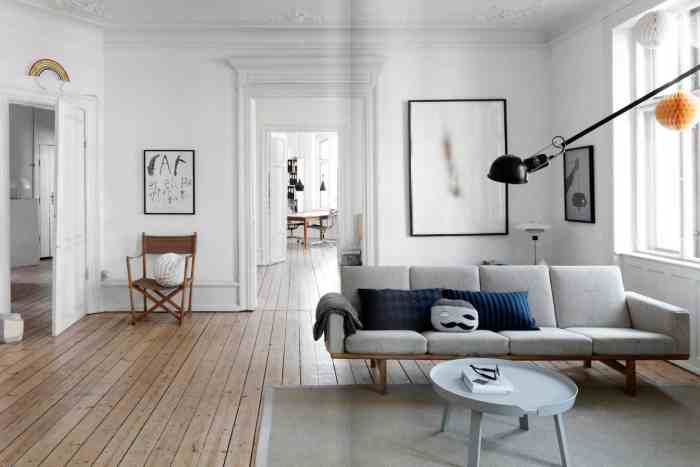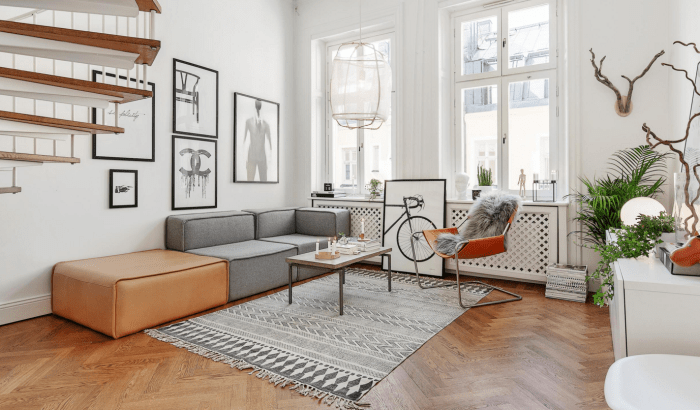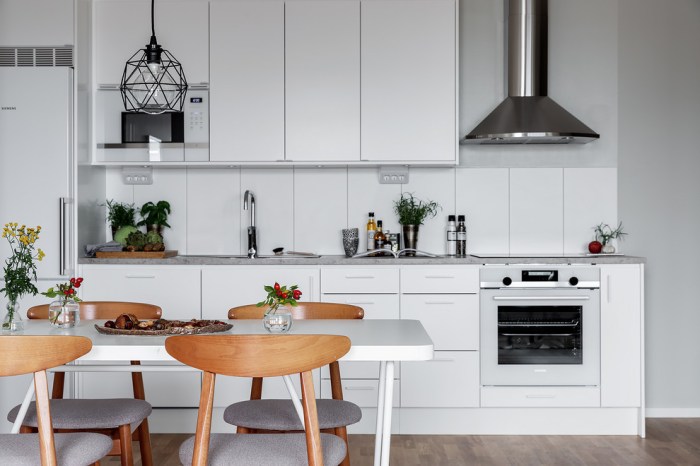Step into the realm of Scandinavian Simplicity: Minimalist Elegance from the North, where functionality, natural beauty, and understated luxury intertwine. This design philosophy, rooted in the Nordic region, has captivated hearts and homes worldwide, offering a serene and sophisticated living experience.
As we delve into the principles and elements of Scandinavian design, prepare to be inspired by its clean lines, earthy tones, and harmonious connection with nature. Discover how this aesthetic transforms interiors into havens of tranquility and timeless style.
Scandinavian Design Principles
Scandinavian design, with its emphasis on simplicity, functionality, and natural materials, has become synonymous with minimalist elegance. These fundamental principles have shaped the aesthetic of Scandinavian interiors, creating spaces that are both stylish and inviting.
Simplicity is a cornerstone of Scandinavian design. Uncluttered lines, neutral colors, and a focus on essential elements create a sense of serenity and order. Functionality is equally important, with every piece of furniture and decor serving a specific purpose. Natural materials, such as wood, leather, and stone, bring warmth and texture to Scandinavian interiors, connecting them to the region’s natural surroundings.
Materials
Natural materials play a vital role in Scandinavian design. Wood, in particular, is a staple, used for everything from furniture to flooring. Its warm tones and organic textures create a sense of coziness and connection to nature. Leather, with its durability and timeless appeal, is another popular choice for furniture and accessories.
Stone, often in the form of granite or marble, adds a touch of elegance and sophistication to Scandinavian interiors.
Color Palette and Lighting
In Scandinavian design, the color palette is typically composed of neutral tones and natural hues, such as white, beige, gray, and black. These colors create a sense of calm and serenity, while also providing a backdrop for more vibrant accents.
Natural light is also an important element of Scandinavian design, as it helps to create a bright and airy atmosphere. Large windows and skylights are often used to maximize natural light, and artificial lighting is typically kept to a minimum.
Neutral Tones
Neutral tones are the foundation of the Scandinavian color palette. These colors are versatile and can be paired with a variety of other colors to create different looks. White is the most popular neutral in Scandinavian design, as it creates a sense of spaciousness and cleanliness.
Beige and gray are also popular choices, as they are warm and inviting.
Natural Hues
Natural hues are another important part of the Scandinavian color palette. These colors are inspired by the natural world, and they can bring a sense of the outdoors into your home. Green, blue, and brown are all popular natural hues in Scandinavian design.
These colors can be used to create a variety of different looks, from calming and serene to vibrant and energizing.
Natural Light, Scandinavian Simplicity: Minimalist Elegance from the North
Natural light is an essential element of Scandinavian design. It helps to create a bright and airy atmosphere, and it can also boost your mood and productivity. Large windows and skylights are often used to maximize natural light, and artificial lighting is typically kept to a minimum.
When artificial lighting is necessary, it is often used to create a warm and inviting atmosphere.
Furniture and Decor

Scandinavian furniture is characterized by clean lines, organic shapes, and sustainable materials. The emphasis is on functionality and simplicity, with pieces that are both stylish and practical.
Wood is a popular choice for Scandinavian furniture, as it is both durable and aesthetically pleasing. Other materials, such as metal, glass, and leather, are also commonly used.
Textiles and Accessories
Textiles and accessories play an important role in Scandinavian interiors. They add color, texture, and warmth to the space. Textiles are often used to create a cozy and inviting atmosphere, while accessories can be used to add a personal touch.
- Textiles: Textiles are often used to add color, texture, and warmth to Scandinavian interiors. Common materials include wool, cotton, and linen.
- Accessories: Accessories can be used to add a personal touch to Scandinavian interiors. Common accessories include candles, vases, and artwork.
Nature and Sustainability
Scandinavian design is deeply rooted in nature, reflecting the region’s stunning landscapes and rich natural resources. Natural elements, such as wood, stone, and textiles made from wool and linen, are commonly incorporated into interiors, creating a sense of warmth and organic beauty.
Sustainability is also a key principle in Scandinavian design. Designers prioritize the use of eco-friendly materials, such as recycled wood and bamboo, and focus on creating products that are durable and long-lasting. This emphasis on sustainability helps to minimize environmental impact and promote responsible consumption.
Natural Materials
Wood is a cornerstone of Scandinavian design, used in everything from furniture to flooring. Its natural warmth and texture add a touch of coziness to any space. Other popular natural materials include stone, leather, and wool, which contribute to the organic and inviting atmosphere of Scandinavian interiors.
Sustainable Practices
Scandinavian designers are committed to reducing their environmental footprint. They use eco-friendly materials, employ sustainable production methods, and design products that are built to last. By prioritizing sustainability, they aim to create interiors that are both stylish and environmentally conscious.
Inspiring Examples

The principles of Scandinavian simplicity, functionality, and natural elegance are beautifully showcased in numerous interiors across the Nordic region. These spaces embody the essence of Scandinavian design, creating harmonious and inviting environments that inspire and uplift.
To provide a visual representation of Scandinavian design, let’s explore a gallery of inspiring examples:
Living Room Inspiration
| Image | Description |
|---|---|
| [Image of a living room with white walls, wooden floors, and a cozy sofa] | A serene and inviting living room featuring a neutral color palette, natural materials, and a comfortable seating area. |
| [Image of a living room with large windows, a fireplace, and a minimalist rug] | A bright and airy living room that combines natural light with warm accents, creating a cozy and inviting atmosphere. |
| [Image of a living room with a mix of vintage and modern furniture, and a gallery wall] | A charming living room that blends classic and contemporary elements, showcasing the eclectic and personal style of its occupants. |
Final Wrap-Up: Scandinavian Simplicity: Minimalist Elegance From The North

In essence, Scandinavian Simplicity is a testament to the power of less. It embraces the beauty of simplicity, functionality, and natural elements, creating spaces that are both visually stunning and incredibly livable. Whether you’re seeking a complete home makeover or simply a touch of Nordic elegance, this design philosophy offers an enduring and universally appealing aesthetic.
FAQ
What are the key principles of Scandinavian design?
Simplicity, functionality, and natural materials are the cornerstones of Scandinavian design.
How does natural light influence Scandinavian interiors?
Natural light is highly valued and maximized in Scandinavian design, creating bright and airy spaces.
What materials are commonly used in Scandinavian furniture?
Wood, leather, and natural textiles are popular choices, known for their durability and sustainability.
